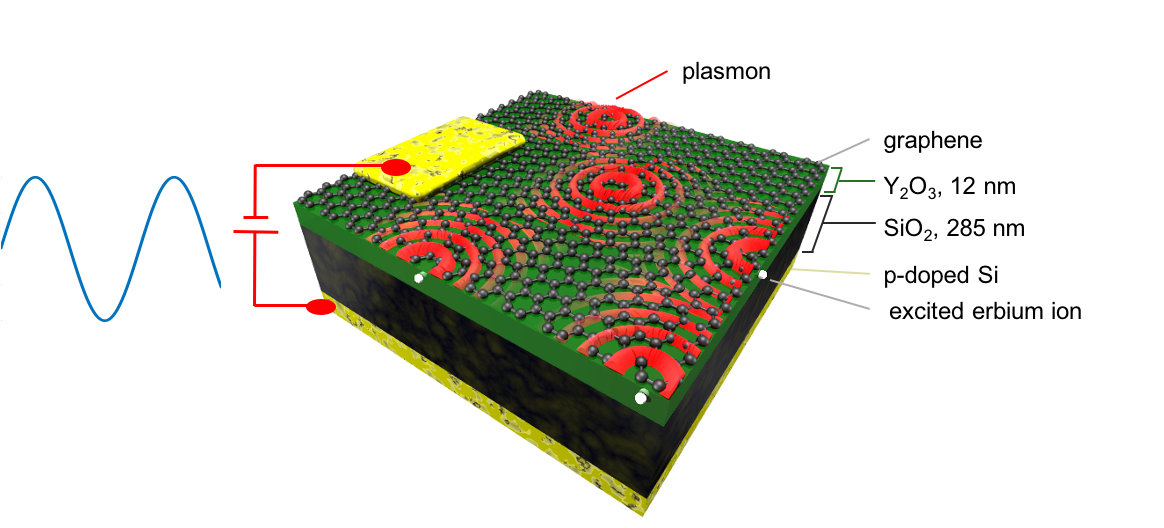Wednesday, 26 August 2020
Fast electrical modulation of nanoscale erbium-graphene systems towards quantum technology applications
A research recently published in Nature Communications shows that a nanolayer of erbium light emitters combined with monolayer graphene exhibits extremely strong near-field interactions, whose strength can be modulated orders of magnitude faster than the natural decay rate of the erbium emitters. This hybrid erbium-graphene material platform opens up exciting possibilities, including manipulation of quantum states. This study has been carried out by a team of scientists that includes ICN2 Junior Group Leader Dr Klaas-Jan Tielrooij, and colleagues from ICFO in Barcelona and IRCP in Paris.

Quantum technologies promise to revolutionize information technology and communications by taking advantage of some peculiar aspects of quantum physics, such as quantum state superposition and entanglement. Research is moving forward in different directions with the goal of building optimal devices for quantum information processing, secure communication, and high-precision sensing.
Systems based on rare-earth ions, such as erbium, are very relevant to this quest, in particular because they typically have very long decoherence times, which means that quantum states persist longer than in other systems. Furthermore, erbium emits light at a wavelength of 1.5 micrometers, one of the main bands for optical communications systems. Hybrid systems containing nanoscale rare-earth components may prove highly versatile and useful to meet the needs of various (quantum) optoelectronic applications.
A team of researchers including Dr Klaas-Jan Tielrooij, leader of the Ultrafast Dynamics in Nanoscale Systems group at the ICN2, and scientists from the Institute of Photonic Sciences (ICFO) and the Institut de Recherche de Chimie Paris (IRCP) have combined a 10 nm thin film of an erbium-doped oxide crystal with monolayer graphene. This hybrid system exhibits extremely strong emitter-environment interactions due to the physical closeness of the emitters to graphene, and the strong dipole-dipole coupling to Dirac electrons.
Their study, recently published in Nature Communications, showed that a large fraction of excited erbium ions decays more than a thousand times faster than normal due to the presence of graphene. This implies that more than 99.9% of the energy flows from these excited emitters to graphene through near-field interactions – where the near-field is the region of the electromagnetic field closest to the object that emits the radiation; in this specific case, it means at a distance from the emitter much smaller than the wavelength of the emitted light. The energy that is transferred from excited emitters to graphene leads to either electron-hole pair generation or plasmon launching (see illustration) in graphene, depending on the Fermi energy of graphene.
Moreover, as reported in the paper, the authors were able to efficiently control the near-field interactions of this hybrid system and to modulate them dynamically by applying a small electrical voltage of just a few volts. This is possible because the gate voltage allows for tuning graphene’s Fermi energy over a large range. The emitter-environment interactions were controlled with high modulation frequencies — up to 300 kHz, which is three orders of magnitude higher than the emitter’s normal radiative decay rate.
This fast dynamic modulation can lead to interesting phenomena and applications, such as the emission of single photons with controlled waveform and quantum entanglement generation by collective plasmon emission. The development of hybrid systems enabling fast control over the near-field interactions, as this erbium-graphene platform, also provides an interesting tool to manipulate quantum states in nanoscale solid state devices by means of conventional electronics. Further studies on these structures will certainly open the way to wider applications in optoelectronic, plasmonic and quantum technologies.
Image: Schematic illustration of the hybrid erbium–graphene system when the Fermi energy of graphene is tuned to ~0.6 eV and the erbium–graphene interaction leads to intraband transitions, mainly associated with launching of propagating graphene plasmons (red waves). The system contains, from top to bottom, a monolayer of graphene, a thin film (~12 nm) of Y2O3 containing erbium ions (white spheres), a 285-nm-thick SiO2 layer, and a p-doped silicon backgate. A backgate voltage is applied between the backgate and a gold electrode in contact with graphene for fast modulation. The SiO2 layer serves as electrical isolation between graphene and the p-doped silicon.
Reference article:
Cano, D., Ferrier, A., Soundarapandian, K. et al. Fast electrical modulation of strong near-field interactions between erbium emitters and graphene. Nat Commun 11, 4094 (2020). DOI: 10.1038/s41467-020-17899-7

